Child-led pediatric therapy, like DIR/Floortime, focuses on building strong emotional connections and relationships as the foundation for a child’s growth. Playfully using a child’s natural interests encourages cognitive, social, and language development. Parents, guardians, and educators often seek ways to better connect with children, and child-led pediatric therapy provides an engaging and practical framework.
Understanding how child-led pediatric therapy can shape a child’s social skills and communication is critical for caregivers. This method invites us to follow the child’s lead, creating a supportive environment where children feel seen and heard. But how can you, as a parent or educator, implement this to maximize its benefits? Let’s explore this approach and discover how it helps children thrive in learning and everyday interactions.
Key Takeaways: Insights on DIR/Floortime Child-Led Therapy
- DIR/Floortime is a child-led therapy focusing on emotional connections and enhancing cognitive, social, and language development.
- It values each child’s uniqueness, tailoring interventions based on developmental levels and individual differences.
- The therapy promotes relationship-centered learning, strengthening bonds between children and caregivers.
- Implementation involves daily sessions, creating a distraction-free environment, decoding the child’s cues, and establishing positive interactions.
- Further training resources include DIR/Floortime Training Leaders, books by Dr. Greenspan and Serena Wieder, and online resources.
Understanding DIR/Floortime Therapy
Embracing the core of child-led therapies, DIR/Floortime therapy, also known as Developmental, Personalized, Relationship-Based therapy, offers a unique and original approach to pediatric medicine. This method centers on emotional connections with caregivers to promote children’s cognitive, social, and language development. The philosophy of DIR/Floortime therapy is guided by the principle of building and nurturing relationships, creating a joyful and organic learning environment for the child.
In this therapeutic model, the child is the driving force. The child leads the play based on their interests, fostering shared attention and engagement. This approach challenges and expands the child’s play, celebrating every achievement, regardless of size. As parents of autistic children know, understanding and accepting their child’s way of interacting with the world is essential. Such an approach boosts the child’s development and enables caregivers to improve their confidence and skills in nurturing their child’s growth.
The advantages of DIR/Floortime therapy are numerous. It enhances the child’s social-emotional skills, improves communication abilities, reinforces sensory processing, and encourages increased engagement and motivation. Essentially, it is an empowering, child-centered approach that promotes comprehensive child development.
Core Principles of DIR/Floortime
The Core Principles of DIR/Floortime are rooted in understanding developmental levels, embracing distinct differences, and fostering relationship-based learning. These principles guide therapeutic interventions, making them adaptable to each child’s strengths, challenges, and interests. Just as autism advocates empower individuals through celebrating particular strengths and promoting self-determination, so does DIR/Floortime value the uniqueness of each child. This method creates a secure and enriching environment for the child, fostering an empowering and child-led approach to growth and learning.
Understanding Developmental Levels
In DIR/Floortime therapy, understanding a child’s specific developmental stages is of utmost significance. The core principles of this approach highlight the importance of tailoring interventions based on each child’s distinct developmental level. This understanding guides therapists, enabling them to create suitable strategies that resonate with the child’s unique pace of development. Exceptionally, for children on the spectrum, eye contact challenges can be a significant aspect to keep in mind while designing these interventions.
Understanding these developmental stages is not simple, but it is crucial in fostering a sense of security and trust within the child. This child-centered approach is built on embracing the child’s variances while acknowledging their strengths, challenges, and interests, such as their distinct communication styles. A deep understanding of these developmental stages supports creating an environment conducive for the child to investigate and grow, nurturing their innate potential.
The backbone of DIR/Floortime therapy is the ability to recognize and address the developmental stages, and a strong understanding of individual variances forms the backbone of DIR/Floortime therapy. This approach can effectively meet the child’s developmental needs, facilitating their exploration towards optimal growth and development and, ultimately, a more fulfilling life.
Embracing Individual Differences
While each child is unique in their strengths, challenges, and interests, the core principle of Personalized Differences in DIR/Floortime therapy places significant emphasis on recognizing and celebrating these unique attributes. This approach acknowledges each child’s development pace, forming a solid foundation for learning and growth.
Understanding the individual variances among children allows for tailored interventions, which are fundamental in fostering a child-led therapeutic environment. By embracing these distinctions, DIR/Floortime creates a holistic and practical therapy environment that nurtures the child’s distinct characteristics and facilitates their overall development.
The table below illustrates the key aspects of embracing individual differences in DIR/Floortime therapy:
| Core Elements | Importance |
|---|---|
| Recognizing Personalized Differences | Tailoring interventions to meet specific needs |
| Celebrating Personalized Differences | Building a solid foundation for learning and growth |
| Embracing Personalized Differences | Creating a holistic, child-led therapy environment |
Fostering Relationship-Based Learning
Building upon the foundation of embracing distinctive differences, DIR/Floortime therapy strongly emphasizes relationship-centered learning. This approach, central to relationship-focused therapy, recognizes the pivotal role of emotional connections between children and their caregivers in supporting development. By following the child’s lead in play and creating shared moments of joy, therapists and parents can make a secure, engaging environment that fosters the child’s communication and social-emotional skills.
This therapy approach involves teaching specific skills and nurturing a deep, meaningful connection. This connection is developed by being present, playful, and responsive to the child’s cues. Celebrating the child’s achievements, no matter how small helps build their confidence and encourages further communication attempts.
Implementing DIR/Floortime at home involves creating a safe and inviting play space, dedicating regular playtime, and embracing the chaos that comes with play. Doing so fosters learning and nurtures a loving relationship that is the foundation for the child’s comprehensive growth and development. The emphasis on relationship-centered learning makes DIR/Floortime a distinctive, effective, and compassionate approach to pediatric therapy.
The Role of DIR in Development
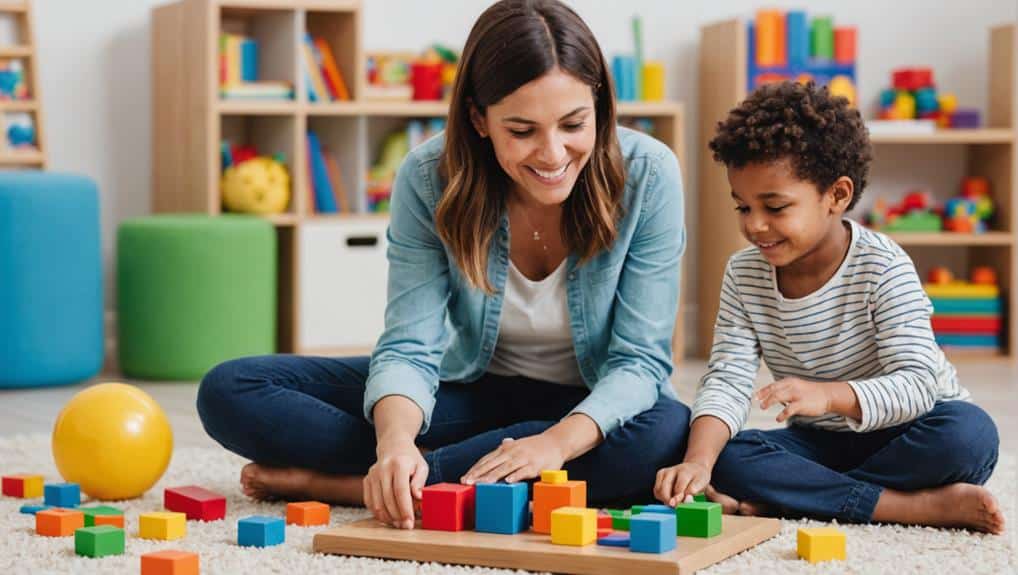
The Developmental, Personal variances, Relationship-based (DIR) model is critical in nurturing social-emotional maturation and understanding distinct differences, especially in children with developmental challenges. Its application through DIRFloortime, a child-led therapeutic approach, presents numerous advantages by highlighting emotional connections and relationships as catalysts for healthy development. This approach respects each child’s developmental path, showcasing its relevance in practical application and the potential benefits that can be derived.
Understanding the DIR Model
Centered around three fundamental growth aspects, the DIR model—an acronym for Developmental, Distinctive Differences, and Connection-based—underscores the importance of social-emotional development. It aims to build solid foundations for social, emotional, and intellectual capacities, emphasizing relationships’ role in fueling human development.
The DIR model is the theoretical framework that underpins DIRFloortime, a practice commonly used for children facing developmental challenges. By focusing on each child’s distinct developmental profile and unique differences, the DIR model provides a pathway for meaningfully understanding and interacting with children. This compassionate approach respects the child’s distinctiveness, fostering a strong, trusting relationship that forms the basis for meaningful interactions and growth.
The DIR model is an effective tool in promoting healthy development in children with autism or other developmental issues. By understanding a child’s distinctive developmental needs and utilizing the power of relationships, this model helps these children reach their fullest potential. It is a guiding light for those nurturing these children toward a brighter future.
Benefits of the DIR Approach
Emphasizing the principles of the DIR model, one discovers various benefits this approach brings to the table, especially in child development. With its central focus on social-emotional growth, the DIR approach aids children in overcoming developmental obstacles by nurturing a solid foundation for learning and progress. This is particularly evident for children with autism, where the significance of early identification and intervention cannot be emphasized enough.
The DIR approach supports early intervention and enables prompt access to suitable therapies. This method is especially advantageous for children with autism, providing them with the abilities required to achieve their full potential. Acknowledging individual disparities, DIR tailors interventions to each child’s developmental phase. This personalized strategy guarantees that each child receives the care and attention they need, aiding them in making significant strides in their developmental path.
The role of parents in this approach is crucial. They are encouraged to foster nurturing relationships with their children, a pivotal aspect of healthy growth. DIR also encourages communication, involvement, and emotional regulation skills. Cultivating these essential skills equips children with the resources to navigate their surroundings effectively. This empathetic, meticulous approach reaffirms its dedication to serving others, making it a valuable tool in pediatric therapy.
Applying DIR in Practice
Using the Developmental, Personal Differences, Relationship-based (DIR) model principles, practitioners have found a reliable tool for facilitating social-feeling development and nurturing relationships in children, particularly those facing developmental challenges such as Autism Spectrum Disorders. In this model, understanding the child’s sensory limits is vital, allowing practitioners to customize their approach effectively. This practical application of this model, DIRFloortime, provides a child-led, sensible, compassionate therapy approach.
The application of DIR in practice involves:
- Following the child’s lead involves observing and participating in their activities to build a connection and understand their distinct developmental process.
- Challenging the child: By introducing new ideas and activities, practitioners can push the child’s boundaries and enrich their cognitive and feeling growth. This may include introducing appropriate mindfulness activities, which can play a significant role in stress relief.
- Building emotional connections: The relationship-based nature of DIRFloortime encourages practitioners to foster emotional bonds with the child, which aids in their social-feeling development.
In essence, DIRFloortime gives practitioners a means to serve those children who need it the most. It enables them to create an environment where children can thrive emotionally, socially, and intellectually while strengthening caregivers to promote their child’s development effectively.
Implementing Floortime Sessions
Implementing Floortime sessions in a child’s daily routine can significantly improve their developmental progress. A prominent figure in the field, Dr. Stanley Greenspan, suggests 6-8 daily Floortime sessions, each lasting around 20 minutes, for the best results. However, the quality of these sessions is equally, if not more, crucial than the quantity. It’s vital to remember that early identification of developmental concerns can lead to more effective interventions such as Floortime.
The creation of a distraction-free environment forms the basis of practical Floortime sessions. This setting allows the child to engage actively, helps the caregiver to focus on the child, and fosters a fruitful interaction. This supportive environment becomes the stage where the child’s distinct world unfolds. This approach aligns with recommendations for establishing a supportive setting for children with autism.
During Floortime sessions, the caregiver should aim to be fully present, observing and participating in the child’s activities. The caregiver’s role isn’t to control but to join the child’s play, following their lead and interests. This approach helps to shift Floortime from a mere task to a relationship-building activity.
Highlighting being present at the moment and prioritizing the relationship over tasks during Floortime sessions can lead to optimal developmental outcomes. This change in focus nurtures a stronger bond between the child and the caregiver, facilitating the child’s comprehensive growth.
Decoding Child’s Cues in Floortime
While Floortime sessions position the caregiver as an active participant in a child’s world, they also necessitate the caregiver to become an insightful observer. Decoding the child’s cues involves recognizing and responding to subtle signals and gestures, a pivotal aspect of the child-led approach. This can be accomplished through intentional nonverbal communication, active listening, and observing the child’s cues. In the context of early intervention for children with autism, such observational skills can lead to timely access to appropriate therapies, enhancing the overall effectiveness of the intervention.
- Recognizing nonverbal communication: Children often convey their feelings and needs through nonverbal cues. By tuning into these signals, caregivers can respond appropriately and dynamically during Floortime.
- Active listening: This involves more than just hearing words. It means understanding the feelings and intentions behind a child’s actions and fostering a supportive and nurturing environment.
- Observing child’s cues: Careful observation can help caregivers tailor interactions based on the child’s interests, thereby enhancing engagement in Floortime activities.
Understanding and responding to a child’s emotional cues are vital in building a solid connection and promoting developmental progress. Advocating for the child’s developmental needs, as highlighted in the early diagnosis process, is integral in this approach. This level of intuitive communication is instrumental in the child-led approach and contributes to the effectiveness of Floortime sessions. The caregiver’s role is multifaceted – actively participating, observing, and decoding the child’s cues to optimize the therapeutic benefits.
Building Positive Interactions Through Floortime
In Floortime’s realm of influence, establishing positive connections lies at the core of its approach. This child-driven method aims to build on interactions by embracing the child’s innate interests during play, nurturing a welcoming, supportive environment that strengthens emotional bonds and social development.
The Floortime approach enables caregivers to fortify their connection with the child and enhance communication skills. By following the child’s lead, caregivers participate in a shared world of the child’s imagination and create a secure space where the child feels understood and encouraged. This supportive environment is vital in the child’s development, making them feel cherished and esteemed.
Positive interactions in Floortime, hence, are not just playtime. They are pivotal moments of joyful engagement that ignite meaningful learning opportunities. These interactions form the basis for the child’s social, emotional, and intellectual advancement. By embracing the child’s cues and interests, Floortime allows caregivers to meet the child where they are, establishing positive connections that nurture a lifelong passion for learning and closeness.
Encouraging Playful Engagement
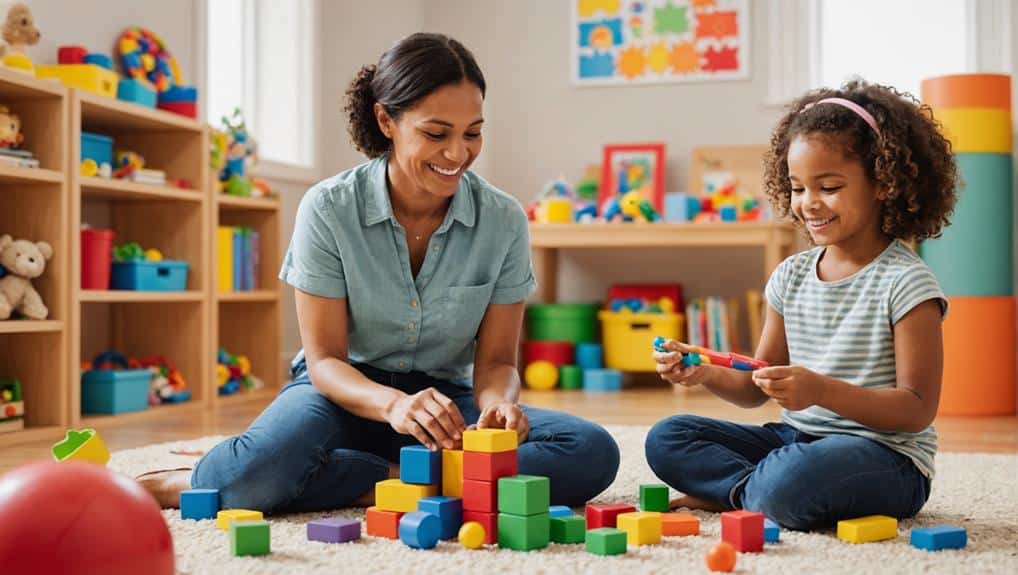
Encouraging playful engagement plays a crucial role in the success of the DIR/Floortime approach. This child-led approach, which involves following the child’s lead during play, helps forge a heart and creates a solid connection essential for their social-emotional development.
Implementing playful engagement requires patience, understanding, and keen observation. Below are a few guidelines to help facilitate this process:
- Follow the Child’s Lead: Engage in activities that pique the child’s interest. This makes the interaction more enjoyable and fosters the child’s self-esteem and confidence.
- Be Present and Playful: Parents and caregivers must be fully present, responsive, and playful. This interactive play helps develop shared attention and expand the child’s play skills.
- Provide a Safe and Supportive Environment: This approach helps children feel secure and supported, fostering positive relationship development and skill advancement.
In the DIR/Floortime approach, encouraging playful engagement isn’t just about having fun; it’s about nurturing the child’s social-emotional development and building meaningful relationships.
The History of Floortime
Floortime therapy, a pioneering approach in pediatric treatment, originated in the 1980s through the collaborative efforts of Dr. Stanley Greenspan and Serena Wieder. Their work, underpinned by the Developmental, Unique Differences, Relationship-based (DIR) model, emphasized the importance of feeling development and relational bonds in a child’s growth path. This inventive therapy has profoundly influenced pediatric therapeutic strategies, demonstrating the effectiveness of fostering a joyful, child-led learning environment.
Origin of Floortime
Emerging in the 1980s, Floortime was the brainchild of Dr. Stanley Greenspan, who, along with Serena Wieder, created a relationship-based therapy model known as the Developmental, Personal Differences, Relationship-based (DIR) model. Their inventive approach was designed to foster emotional development and nurture strong, healthy relationships for children.
Floortime was born out of three fundamental principles:
- Emphasizing the importance of each child’s distinct developmental trajectory.
- We recognize differences in each child’s sensory processing and motor planning abilities.
- We prioritize relationships and interactions’ role in a child’s development.
The approach seeks to help children reach their full potential by providing a natural and joyful learning environment, created with the understanding that every child deserves a compassionate, respectful, and informed approach to learning. Floortime has proven to be a powerful tool for families and therapists dedicated to serving children and helping them grow in an atmosphere of love, understanding, and respect. This progressive therapy model has not only transformed therapeutic practices but also enriched countless lives, making it a pivotal chapter in the history of pediatric care.
Key Floortime Developers
Two prominent figures in pediatric therapy stand out for their pioneering contributions: Dr. Stanley Greenspan and Serena Wieder, PhD. Their groundbreaking work in the 1980s led to the development of Floortime, a therapeutic approach based on the Developmental, Personalized Differences, Relationship-Based (DIR®) model.
Dr. Greenspan, a distinguished psychiatrist, firmly believed in the importance of emotional development and nurturing relationships with caregivers for a child’s comprehensive growth. Serena Wieder, a respected clinical psychologist, shared this belief, and together, they aimed to cultivate a distinctive, child-centered approach to therapy.
Floortime engages children in interactive play tailored to their unique strengths, challenges, and interests. This approach places the child at the heart of therapy, emphasizing their variances and relationships with caregivers.
The DIR® model serves as the theoretical foundation for Floortime. It honors each child’s distinct developmental process, fostering their emotional and intellectual growth in a compassionate, detailed manner. Dr. Greenspan and Dr. Wieder’s work has impacted the field of pediatric therapy, creating an enduring influence on countless lives through their Floortime approach.
Impact on Pediatric Therapy
Undoubtedly, the emergence of Floortime therapy in the 1980s marked a pivotal shift in pediatric care. The brainchild of Stanley Greenspan, M.D., and Serena Wieder, Ph.D., this approach transformed pediatric therapy, centering sentimental development and relationship-building as the core components of work with children facing developmental challenges.
The impact of this child-led approach on pediatric therapy has been profound. Therapists have nurtured secure attachments by prioritizing sentimental connections, following the child’s lead, and promoting cognitive, social, and language development. Here are three key ways this has changed pediatric therapy:
- Child’s Interests: Rather than imposing a fixed therapy plan, Floortime encourages therapists to follow the child’s interests, making therapy more engaging and effective.
- Sentimental Connections: Floortime has emphasized the importance of understanding and responding to a child’s emotional needs in therapy by establishing sentimental connections.
- Holistic Development: With its all-encompassing approach, Floortime has helped children reach their full potential by addressing not just their physical but also their sentimental, social, and cognitive development.
Floortime Therapy Providers
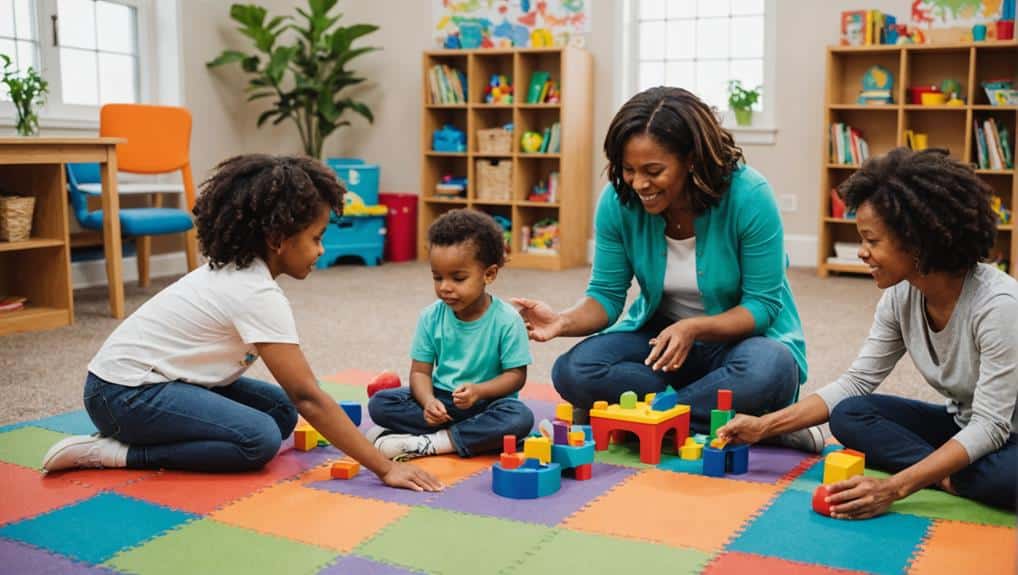
Addressing the needs of children with developmental differences often involves a team of dedicated professionals, including child psychologists, special education teachers, speech therapists, and occupational therapists. These professionals are all potential Floortime therapy providers, trained to tailor interventions based on a child’s distinct developmental stage and personal differences.
Moreover, parents and caregivers can learn Floortime techniques to enrich their child’s development at home. This offers a continuum of support, allowing children to progress in a familiar setting. Following the child’s lead, these providers help to build relationships crucial for cognitive, social, and language development.
The strength of Floortime therapy lies in its comprehensive approach. It creates a natural and joyful learning environment, encouraging children to investigate and interact with their surroundings. This approach emphasizes the importance of emotional and relational development as well as cognitive and language skills.
Floortime therapy providers are vital to a child’s developmental journey. Their knowledge, dedication, and compassion significantly impact the lives of children with developmental differences and the families who care for them.
Benefits of DIR/Floortime Therapy
Utilizing the power of DIR/Floortime therapy yields substantial benefits for children with developmental differences and their caregivers. This distinctive approach bolsters social-emotional skills, fostering improved communication and relationships. It also boosts sensory processing abilities, equipping children to navigate their environment more effectively.
Here are three significant benefits of DIR/Floortime therapy:
- Promotion of Shared Attention and Engagement: DIR/Floortime therapy encourages children to engage with their surroundings and develop shared attention. This increased engagement and motivation cultivate a love for learning and exploration.
- Empowerment of Caregivers: Caregivers play a crucial role in the child’s development and learning. DIR/Floortime equips them to create supportive environments that nurture their child’s growth and well-being.
- Strengthening of Relationships: DIR/Floortime builds trust and supports healthy growth by facilitating stronger connections between children and their caregivers.
Floortime at Home: A Practical Guide
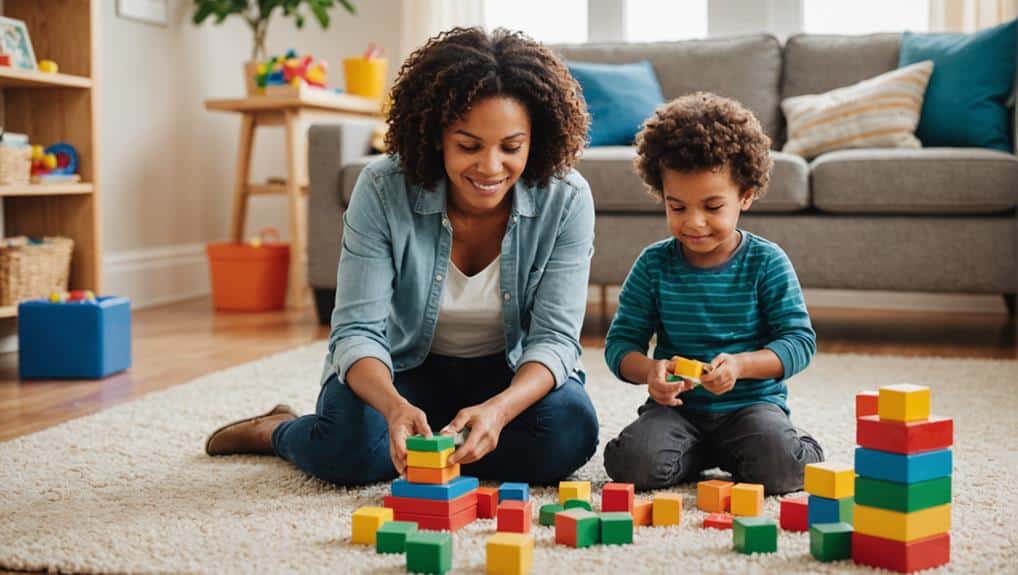
Integrating Floortime therapy into the home environment can be a rewarding and effective way to continue your child’s development. The initial step involves establishing a safe, engaging space for dedicated play time, ensuring a supportive setting for these child-led interactions. By attentively tuning in to your child’s cues and interests, you can adapt and respond to optimize the growth potential of each Floortime session.
Setting the Play Space
Planning and creating a dedicated play space is essential to successfully implementing Floortime therapy at home. This child-led approach to pediatric therapy requires a safe and engaging play area that promotes focused interaction and encourages the child’s natural curiosity.
- Ensure a Distraction-Free Setting: The play space should be free from distractions. This involves minimizing the presence of non-essential electronics and other items that could divert the child’s attention from the interactive play.
- Equip with Child-Friendly Supplies: Populate the space with child-friendly materials and toys. These should align with the child’s interests to foster engagement and make the therapy more effective. Remember, a child-led approach like Floortime values the child’s preferences and developmental needs.
- Create a Stimulating Environment: The play space should stimulate the child’s senses and encourage exploration. A sensory-rich setting can evoke a wide range of responses from the child, supporting their emotional and cognitive development.
Structuring Play Time
While setting up a conducive play area is vital, effectively structuring playtime is equally crucial when implementing DIR/Floortime at home. This child-led approach, central to Engaging Autism, requires creating a calm, distraction-free environment to support the child’s interest, engagement, and development.
Six to eight daily sessions of 20-minute Floortime are recommended at strategic intervals. This structured playtime helps build relationships and fosters developmental achievements. However, shifting Floortime from being task-oriented to a relationship-building activity is essential. This change emphasizes the significance of being in the present moment, focusing entirely on the child, and prioritizing the relationship over completing tasks.
As you join your child in their activities, be observant. Follow their lead, support their initiatives, and engage in authentic reciprocal interactions. This mindful presence helps you understand your child’s distinct way of interacting with the world and strengthens your connection with them. Remember, the goal is not to teach specific skills but to nurture natural, spontaneous interactions that encourage emotional and intellectual growth.
Reading Child’s Cues
An essential component of implementing DIR/Floortime at home is the art of reading a child’s cues. This method requires caregivers to tune into the child’s interests, preferences, and reactions during play. Following They are following’s lead forms the core of this approach, achieved by keenly observing their nonverbal signals and expressive reactions.
Understanding and responding to these cues builds a strong connection and fosters communication, trust, and developmental growth. By acknowledging and reciprocating the child’s cues, caregivers can create a safe and supportive environment for interaction.
- Observe: Note the child’s nonverbal signals and expressive reactions. These are significant indicators of their interests and preferences.
- Understand: Comprehend what the child is trying to communicate through their cues. This understanding is vital to foster communication and trust.
- Respond: Follow the child’s lead by responding to their cues in a supportive manner. This stimulates engagement and promotes a secure interaction environment.
In DIR/Floortime, reading a child’s cues is not just an art; it is the cornerstone of a compassionate, detailed, and practical therapeutic approach.
Addressing Autism With Floortime
Diving into the heart of child-centered therapy, Floortime has emerged as a significant approach to addressing autism spectrum disorders in children. This therapeutic framework fosters a deep connection between children and caregivers, strengthening inherent pathways for cognitive, social, and linguistic development.
Floortime’s cornerstone principle recognizes and celebrates each child’s strengths and interests, creating a nurturing, joy-filled learning environment. The focus is not on shaping children into predetermined societal norms but rather on facilitating the growth of their unique potential.
This therapy addresses Autism Spectrum disorders by tailoring interventions based on the child’s developmental stage and individual differences. Floortime’s ultimate goal is to support healthy development with interventions that resonate with the child’s distinctiveness. The child’s lead is respected and followed, and their specific rhythm and preferences guide the therapeutic voyage.
At its core, Floortime is about enabling children with autism to reach their fullest potential in a caring, understanding setting. An approach that promises to transform the lives of children on the Autism Spectrum, Floortime is a guiding light of hope for an inclusive, empathetic future.
Enhancing Communication With Floortime
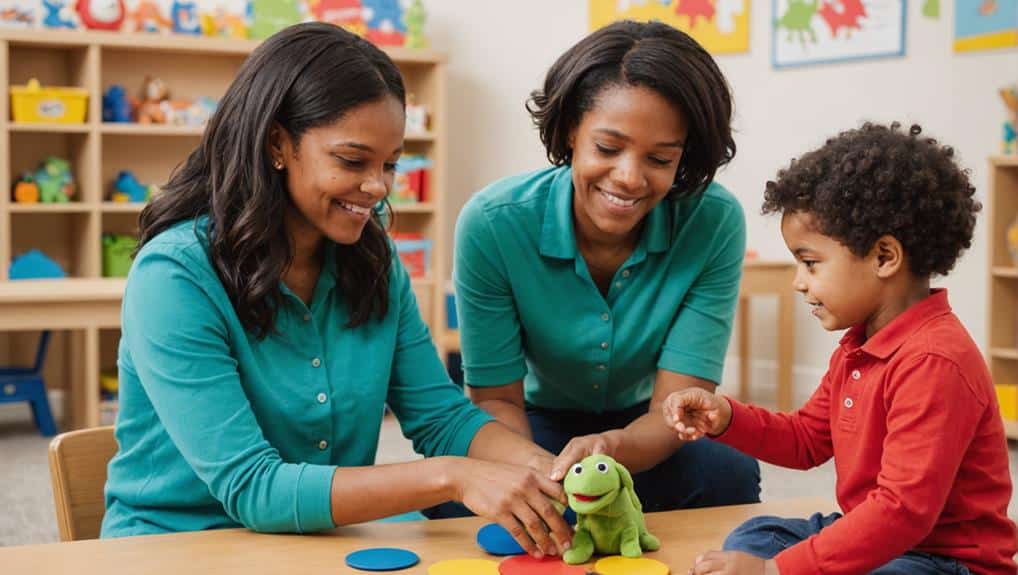
Building on Floortime’s child-centered approach, the therapy also serves as a powerful tool for improving communication skills in autistic children. This therapy approach focuses on the child’s natural interests, creating a supportive environment that encourages two-way communication and social engagement.
Floortime therapy utilizes three key strategies to boost communication:
- Child-led play: Therapists and caregivers join the child at their level, following their lead in promoting interaction.
- Back-and-forth interactions: These exchanges, initiated by the child, nurture communication skills and foster understanding of feelings.
- Expanding communication circles: Floortime sessions allow children to interact with multiple people, developing their social and communication skills.
The goal of Floortime is not solely to increase the number of words a child can say or understand. It is about strengthening the fundamental relating, communicating, and thinking capacities. By focusing on these critical areas, Floortime therapy helps children with autism to express their thoughts and feelings more effectively, fostering deeper connections on an emotional level and improving their overall communication skills.
Child-Led Pediatric Therapy Success Stories
Through inspirational accounts, the effectiveness of Floortime therapy becomes clearer. Many parents, practitioners, and researchers have confirmed the therapy’s ability to nurture emotional connections, enhance social skills, and promote holistic development.
Consider the instance of a child with autism whose parents observed significant progress in communication and social skills after consistent Floortime therapy sessions. Then, there’s the tale of a child with developmental delays who, through Floortime therapy, displayed a remarkable leap in engagement and interaction.
Furthermore, Floortime therapy has been pivotal in cultivating solid parent-child relationships. One family shared their pivotal moment when they experienced a heartfelt emotional connection with their child during a Floortime session.
| Inspirational Account | Impact of Floortime Therapy |
|---|---|
| Autism Case | Enhanced communication and social skills |
| Developmental Delay Case | Heightened engagement and interaction |
| Parent-Child Relationship Case | Nurtured emotional connection |
These uplifting accounts underscore the potential of Floortime therapy to create meaningful changes in children’s lives. They validate the therapy’s value, offering hope and inspiration for families beginning their Floortime voyage.
Further Resources for DIR/Floortime Understanding
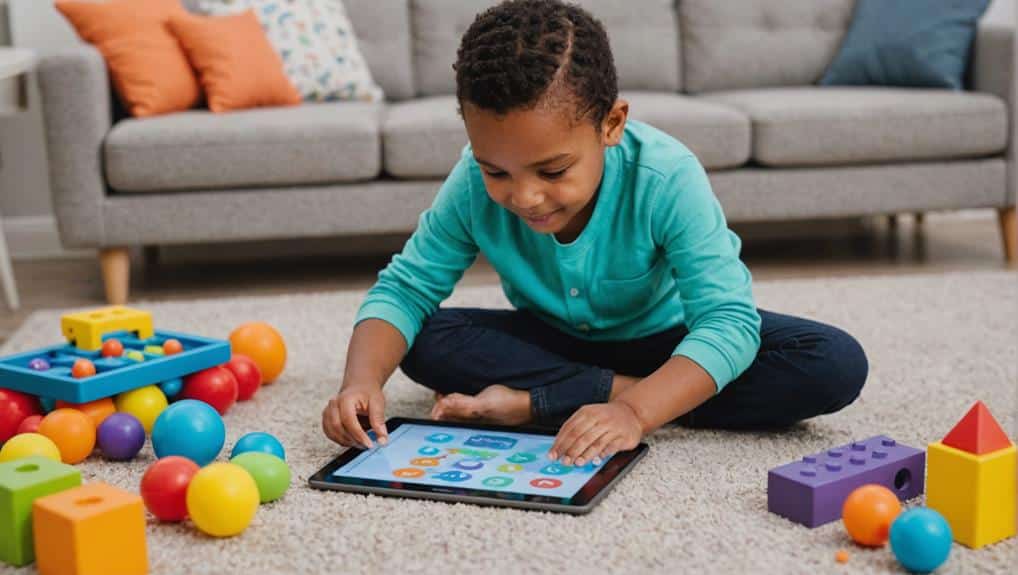
Exploring the intellectual foundations and practical tools is crucial to grasp the essence of DIR/Floortime therapy fully. This approach, developed by Dr. Stanley Greenspan and Serena Wieder, is a child-led therapy primarily designed for children on the autism spectrum. It focuses on emotional bonds with caregivers to improve cognitive, social, and language development.
The core principles of DIR/Floortime involve understanding developmental stages, acknowledging unique differences, and nurturing relationship-based interactions. It promotes following the child’s cues, establishing shared engagement, and celebrating every accomplishment.
A few resources that can be pivotal in understanding and implementing DIR/Floortime therapy are:
- The DIR/Floortime Training Leaders: These professionals offer in-depth training for parents and professionals to comprehend and apply DIR/Floortime effectively.
- Dr. Greenspan and Serena Wieder’s books provide detailed insights into the approach, its advantages, and application methods.
- Online resources: Websites, webinars, and online forums offer valuable insights, experiences, and practical suggestions for implementing the therapy.
These resources offer a thorough understanding of DIR/Floortime and its utilization, assisting those who aspire to serve and support the development of children on the autism spectrum.
Frequently Asked Questions
What Is the DIR/floortime Approach?
DIR/Floortime is a pediatric therapy method emphasizing personal connections and relationships for cognitive, social, and language development. It is child-led, celebrating each child’s strengths and fostering a secure, explorative learning environment.
What Is the DIR Framework?
The DIR framework is a creative method focusing on Developmental, personalized differences, and Relationship-based aspects of a child’s growth. It significantly emphasizes social-emotional development as a critical component of holistic personal progress.
What Is the Difference Between ABA and DIR/floortime?
ABA focuses on modifying behaviors through structured interventions and rewards. In contrast, DIR/Floortime emphasizes personal connections and child-led play to foster holistic development, specifically in children with autism and other developmental challenges.
What Are the Strategies for Floortime Therapy?
Floortime therapy strategies involve creating a serene environment, following the child’s lead in play, and promoting reciprocal interactions. The goal is expanding communication circles and fostering social-emotional development through shared attention and play.
Conclusion
Exploring DIR/Floortime therapy highlights its crucial role in promoting child development. This child-led approach fosters cognitive, social, and language abilities by nurturing personal connections and embracing the child’s passions. Addressing conditions such as autism improves communication and sensory processing, thereby paving the way for a child’s progress in a safe environment. This exploration is a guiding light, directing caregivers toward resources that deepen their comprehension of this life-changing therapy.

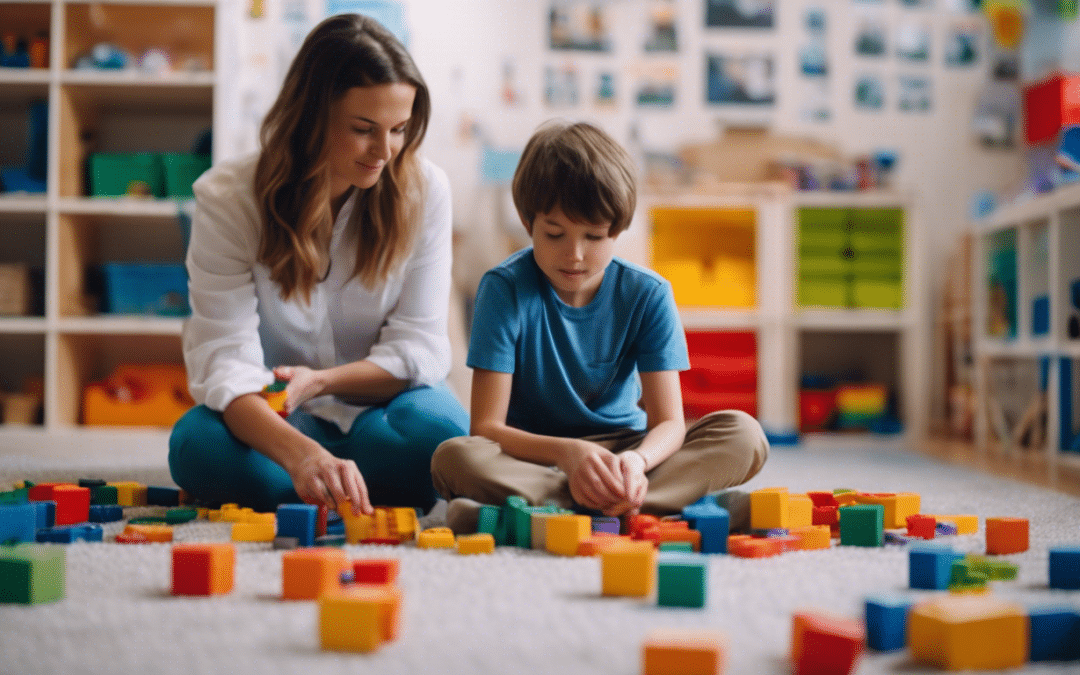
Recent Comments